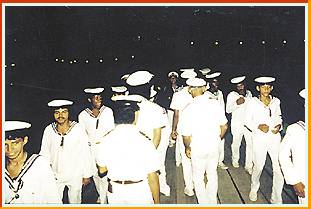
THE
FANDANGO
José Maria Tenório Rocha
 |
 |
The Fandango
is a popular spectacle that brings together : romance, dance, music, anecdotes,
sayings, legends and prayer. This spectacle can normally be found on an
improvised stage at a party, in a patio in front of a church or even
on a decorated boat alongside the beach. The actors wear sailor
costumes. They sing, dance and shout to the sound of string
instruments and provide the percussion sounds with their own tap
dancing. |
The Fandango is an
example of Iberian inheritance, richer and even more alive than ever
in our own popular culture. It dates from the last century, when
Fandangos were seen from the coastal regions all the way through to the hinterlands.
There are still a very few groups left, although sadly it is almost
extinct. The names of the groups reflect very much the region in which they are
based : Marujada, Barca, Chegança de Marujos, Nau Catarineta.
There is always an opening procession to the Fandango, much like the
Greek theatre, with singing and recitations of naval episodes - a ship suffers
from the effects of a tempest, and wanders the seas for 7 years and a
day. Hunger attacks everybody. By drawing lots, one of the crew is
sacrificed to serve the hunger of the rest of the ship's crew. Before executing the
General, who was the unlucky subject drawn, Our Lord performs a miracle and
everyone lands safely in Spain. Meanwhile, Satan has been reincarnated as
the ship's figurehead and does all in his power to stop this from happening. The
other actors are : The Master Captain, the Commandant, the Pilot, the Surgeon, Sabóia,
Marujos and the clowns Vassoura, Ermitão e Ração. We are able to see
The Fandango at Christmas time in Recife in the districts of Sítio Trindade
and Mustardinha, and the smaller cities of Nazaré da Mata, Carpina, Itamaracá, Cabedelo (PB) e Maceió (AL).

|